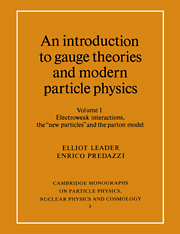Book contents
- Frontmatter
- Contents
- Preface
- Acknowledgements
- Notational conventions
- Note added in proof: the discovery of the top quark (?)
- Note added in proof: the demise of the SSC
- 1 Field theory and pre-gauge theory of weak interactions
- 2 The need for a gauge theory
- 3 Spontaneous symmetry breaking: the Goldstone theorem and the Higgs phenomenon
- 4 Construction of the standard model
- 5 Lowest order tests of the SM in the leptonic sector
- 6 The Higgs boson
- 7 The standard model beyond lowest order
- 8 e+e− physics and the standard model
- 9 Extension to the hadrons; quark–lepton universality
- 10 Phenomenology of semi-leptonic reactions
- 11 The discovery of the narrow vector resonances
- 12 Hidden flavour bound states
- 13 Open heavy flavours
- 14 The heavy lepton τ
- 15 Towards the parton model—deep inelastic scattering
- 16 The quark–parton model
- 17 Experimental tests of the quark-parton model
- Appendix 1 Elements of field theory
- Appendix 2 Feynman rules for QED, QCD and the SM
- Appendix 3 Conserved vector currents and their charges
- References
- Analytic subject index for vols. 1 and 2
1 - Field theory and pre-gauge theory of weak interactions
Published online by Cambridge University Press: 19 March 2010
- Frontmatter
- Contents
- Preface
- Acknowledgements
- Notational conventions
- Note added in proof: the discovery of the top quark (?)
- Note added in proof: the demise of the SSC
- 1 Field theory and pre-gauge theory of weak interactions
- 2 The need for a gauge theory
- 3 Spontaneous symmetry breaking: the Goldstone theorem and the Higgs phenomenon
- 4 Construction of the standard model
- 5 Lowest order tests of the SM in the leptonic sector
- 6 The Higgs boson
- 7 The standard model beyond lowest order
- 8 e+e− physics and the standard model
- 9 Extension to the hadrons; quark–lepton universality
- 10 Phenomenology of semi-leptonic reactions
- 11 The discovery of the narrow vector resonances
- 12 Hidden flavour bound states
- 13 Open heavy flavours
- 14 The heavy lepton τ
- 15 Towards the parton model—deep inelastic scattering
- 16 The quark–parton model
- 17 Experimental tests of the quark-parton model
- Appendix 1 Elements of field theory
- Appendix 2 Feynman rules for QED, QCD and the SM
- Appendix 3 Conserved vector currents and their charges
- References
- Analytic subject index for vols. 1 and 2
Summary
Our principal aim in this chapter is to review briefly the basic ideas of field theory, which we shall illustrate with examples from quantum electrodynamics (QED) and the theory of strong interactions, quantum chromodynamics (QCD). Of necessity, we must assume that the reader has some knowledge of field theory and is conversant with the idea of Feynman diagrams and with the Dirac equation. We shall then give a resumé of the theory and phenomenology of the weak interactions as they stood at the time of the inception of the new ideas about quarks and gluons in the early 1970s. The chapter ends with some technical results which will be very useful in later chapters.
The detailed rules for the Feynman diagrams for the various field theories are given in Appendix 2.
A brief introduction to field theory
Processes in which particles can be created or annihilated are best treated in the language of quantum field theory, using field operators ø(x) that are linear superpositions of operators a†(p) and a(p) which respectively create and annihilate particles of momentum p when they act upon any state vector. If the state happens not to contain the relevant particle of momentum p then a(p) acting on it just gives zero (the detailed mathematical relationship can be found in Appendix 1).
- Type
- Chapter
- Information
- Publisher: Cambridge University PressPrint publication year: 1996



